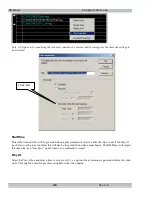
HD Player
Chapter 7: Soft Edging/Display Overlap
50
Rev. 6.8
Chapter 7:
Soft Edging/Display Overlap
The following techniques can be employed to produce high resolution, high brightness displays:
Videowall
The term videowall refers to an image built up by stacking display devices. A Videowall typically uses a complex
digital video processor to split an incoming video source into the multiple outputs sent to the display.
Videowalls offer a very high brightness, high-resolution display in a small physical space. They do, however, have
the negative characteristic that the borders (called mullions) between each display segment are visible and often
distracting.
Single Projector
If space is available in front of, or behind the screen, a single projector system can be used to fill the display with
a single image. The display resolution is limited to the resolution of the projector. Projectors capable of delivering
a large bright image also require expensive and fragile lamps that typically have a limited life.
Introducing Soft Edging
Soft Edging or “Display Overlap” is a technique for generating a single image on a screen when using multiple
projectors. This results in a seamless display that shows no signs of being made up of spliced-together images
from separate projectors.
A soft edged display provides the benefits of both the Videowall and the Single Projector with few of their flaws.
Multiple projection systems allow the designer to utilize smaller and less expensive projectors to display an image
on the same screen area that would otherwise require a single larger and more expensive projector. This technique
achieves greater total pixel resolution and more brightness (lumens), at a lower cost.
Achieving a soft-edged display is a two-step process.
1.
Overlap part of the image from each projector with its neighbor in order to ensure a seamless display. A
typical installation would require 5% of the image to be in the overlap.
2.
Adjust the video output in the overlap to correct for the “doubling” of light output that occurs in the
overlap region between adjacent projectors. The HD Player utilizes sophisticated digital processing to
implement this brightness adjustment.
The following illustration gives an example of a three projector wide display showing the overlap concept (The
projectors are identified as #1 – Left, #2 - Center and #3 – Right, when viewed from the projection location)
Содержание MS9200P
Страница 10: ......
Страница 78: ...HD Player Chapter 12 Remote Control Protocols 78 Rev 6 8 The Player will respond with OK or ERROR ...
Страница 88: ......
Страница 93: ...HD Player Chapter 14 Application Notes 93 Rev 6 8 ...
















































